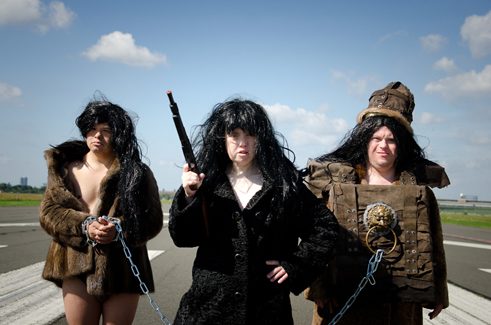Theatre and Participation II
Participation as inclusion of socially disadvantaged actors

That the theatre can be politically efficacious by conveying or representing socially critical content has become for many artists questionable. For the social hierarchy of the theatre reflects the social conditions of inclusion and exclusion in general: who may or may not appear and speak on stage? Whose voice is heard? More and more, therefore, actors from marginalized groups are appearing on stage and seeking directly to redeem their claim to social participation.
For fifteen minutes now the audience of the Great Mongolian Show has been looking expectantly into nothingness. Almost nothing at least. For in addition to the demonstratively empty stage in the cynical format of an ethnological exhibition, three ridiculously costumed “Mongols” are relaxing with a glass of champagne, eating chips and chewing the fat. “Give the others some chips!” says one of the actors at last and betakes herself resolutely to the audience.
In the not uncontroversial production Dschingis Khan by the Gießen collective Monster Truck, the “Mongols” are played by Sabrina Braemer, Johnny Chambilla and Oliver Rincke, actors from the Berlin theatre Thikwa (Hebrew for “hope”). The “others” are embodied at this moment by us, the audience, as representatives of a majority society that excludes people with Down syndrome, such as the Thikwa actors, from everyday participation in important areas of social life.
That in 1866 the English neurologist John Langdon-Down distinguished “mongoloid idiocy” from other mental disabilities was in good intention and the result of a differential diagnosis first introduced by him. Moreover, the term was then expressly directed against a pre-fascist racial theory, which justified slavery. The result, however, was to unite two categories of exclusion: “idiocy” and the other.
Theatre as a promise of emancipation
Such a good intention in the attempt to convey or represent socially critical content is therefore not a sufficient answer to the urgent question of how society should treat the emancipatory needs of people who are not white, male, heterosexual, affluent and educated, and what role the theatre as a public (and publicly subsidized) space should play in this. Good intentions like that always presuppose a hierarchical difference in favour of the well-intended, and in the theatre, as in society at large, conditions of production obtain that are neither democratically organized nor equal for everyone.Precisely for this reason, and because theatre as an art form has always directed a special focus on what the theatre scholar Hans-Thies Lehmann has described as “relational dramaturgy”, the diverse relationships of the actors on stage with the audience and with one another, the live character of theatre as a moment of social boundary negotiation and emancipation has forced itself forward. Since the 1990s and the “social turn” and “performative turn”, says theatre scholar Erika Fischer-Lichte, many artists have bade farewell to the idea that theatre can be politically efficacious by conveying and representing socially critical content. Instead, actors from marginalized groups are themselves appearing on stage and so directly redeeming their claim to social participation.
Forms of participation
How this claim takes aesthetic form varies greatly across the span of participatory theatre today: in addition to positions such as that of Rimini Protokoll, which with its <i>Experten des Alltags</i> invented a new genre of reflecting on reality in theatre, or the often inclusive choral forms of Volker Lösch in municipal theatre, there are now also even institutionalized participatory projects such as the Berlin homeless theatre Rats O7 and the prisoners theatre aufBruch, which both could be developed after the institutional opening of the Berlin Volksbühne am Rosa-Luxemburg-Platz in 1992. There under the artistic director Frank Castorf and the chief dramaturge Matthias Lilienthal the ensemble of actors and dancers was also internationalized, and Christoph Schlingensief’s continuous work with disabled performers challenged the aesthetic and ethical qualities of the theatre in a completely new way. Non-artistic staff of the theatre also organized themselves into a choir and first appeared on stage in Castorf’s Meistersinger.Now, under the increasing political pressure from public subsidy donors, most municipal theatres have expanded their theatre education departments and outreach offerings, work project-related with people of immigrant background and maintain departments for participatory projects with non-professional actors, such as the Citizens’ Stage at the Dresden Schauspiel and the Young DT at the Deutsches Theater in Berlin.
Balancing act of perception
Participatory projects with socially disadvantaged groups always raise the question whether the special qualities of the actors are the focus or whether the stage continues the social stigmatizing of the group. In 2013 the Swiss actress Julia Häusermann was the first person with Down syndrome to win the Alfred Kerr prize for her role in Disabled Theatre, the dance performance of the Theater Hora directed by Jérôme Bel, which was invited to the Berlin Theatre Meeting. To what extent the disabled actors play a “role” and are aware of their situation, or are exhibited by the director in their otherness and so primarily serve the voyeurism of the theatre – in short, whether the participatory promise is fulfilled on stage – was as controversially discussed in the context of this production as in the case of Monster Truck’s Dschingis Khan, which half a year later was invited to the Politics in Independent Theatre Festival.Participation in the theatre creates a negotiating space for social conflicts. Whether it thereby unfolds emancipatory potential is a balancing act that depends on its aesthetic resources, but also decisively on the attitude of the audience.